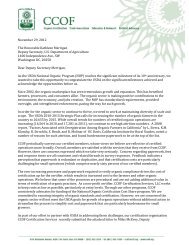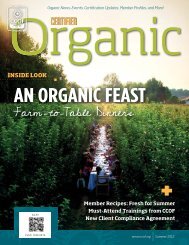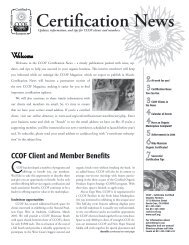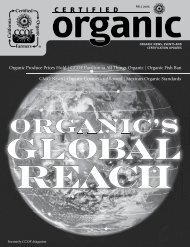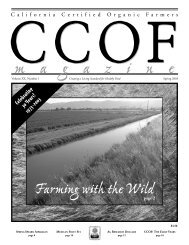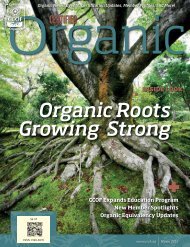Consolidation in Organic Agriculture - CCOF
Consolidation in Organic Agriculture - CCOF
Consolidation in Organic Agriculture - CCOF
Create successful ePaper yourself
Turn your PDF publications into a flip-book with our unique Google optimized e-Paper software.
or <strong>in</strong>formal agreements, <strong>in</strong>clud<strong>in</strong>g mergers,acquisitions, jo<strong>in</strong>t ventures or strategicalliances. Although their boundaries are constantlyshift<strong>in</strong>g, several potentially emerg<strong>in</strong>gclusters have been identified. For <strong>in</strong>stanceCargill and Monsanto form a cluster, withMonsanto provid<strong>in</strong>g genetic material andseeds, and Cargill <strong>in</strong>volved <strong>in</strong> gra<strong>in</strong> collectionand process<strong>in</strong>g, and meat productionand process<strong>in</strong>g. Kroger, the largest supermarketcha<strong>in</strong> <strong>in</strong> the US, is l<strong>in</strong>ked to this clusterthrough an agreement with Cargill to receivecase-ready meat. DuPont/ConAgra andNovartis (Syngenta)/ADM have similar ties. 4Although predictions are very difficult, basedon other <strong>in</strong>dustries that have formed globaloligopolies rather than monopolies (such asautomobiles, pharmaceuticals and oil) thereare likely to be as few as four to six clustersworldwide. 4EFFECTS OF CONSOLIDATIONThe implications of what such a system willmean for farmers can already be seen <strong>in</strong> thepoultry <strong>in</strong>dustry <strong>in</strong> the US. N<strong>in</strong>ety-five percentof chickens produced for meat aregrown under production contracts withfewer than 40 companies. The farmer furnishesthe land and labor, and is required to<strong>in</strong>vest hundreds of thousands of dollars forbuild<strong>in</strong>gs and other equipment. The companyprovides the chicks, feed and medic<strong>in</strong>eand agrees to pay a guaranteed price perpound. In the 1950s, when there were morethan a thousand companies, most poultryfarmers benefited from such contractsbecause they were protected from pricefluctuations. Now that four vertically <strong>in</strong>tegratedfirms control 50% of the market, theterms of the contracts are much more favorableto the companies. Their power is sogreat that some companies have been foundto cheat farmers systematically by underestimat<strong>in</strong>gthe weight of birds, overestimat<strong>in</strong>gthe weight of feed, or provid<strong>in</strong>g poor qualitychicks or feed. A farmer who compla<strong>in</strong>sis likely to have their contract canceled andbe placed on a blacklist. 5 Although mostpoultry farmers are mak<strong>in</strong>g poverty levelwages or below, without a contract theycannot pay off their mortgages, and thereforeface foreclosure. Some cynics have suggested“why buy the farm when you canown the farmer?” and describe chickenfarmers as “serfs” who are never able toescape their debts.Gra<strong>in</strong> and vegetable growers may soonf<strong>in</strong>d themselves <strong>in</strong> a similar situation. Geneticallyeng<strong>in</strong>eered (GE) crops are controlledby just six mult<strong>in</strong>ational corporations, andthe technology is be<strong>in</strong>g used as a tool to consolidatethe seed supply. Crop farmers arethen be<strong>in</strong>g locked <strong>in</strong>to food cha<strong>in</strong> clustersthrough “bundl<strong>in</strong>g,” or l<strong>in</strong>k<strong>in</strong>g patentedseeds with contracts, chemicals and credit.Monsanto’s Roundup Ready seeds can onlybe used with Roundup herbicide, eventhough cheaper versions of this herbicide areavailable. Pioneer DuPont seed gives better<strong>in</strong>terest rates on f<strong>in</strong>anc<strong>in</strong>g, depend<strong>in</strong>g uponhow much “approved” products the farmerbuys, and approved chemicals <strong>in</strong>clude thosefrom Syngenta, Bayer/Aventis, and Dow.The precedent set with GE seeds is alsobe<strong>in</strong>g extended by bundl<strong>in</strong>g chemicals andother <strong>in</strong>puts with conventional seeds. In theUK, Syngenta’s hybrid barley can only bepurchased <strong>in</strong> conjunction with the company’sgrowth regulator and fungicides.Consumers are also harmed by consolidation.GE foods have been <strong>in</strong>troduced <strong>in</strong>tothe food system without public consent, oreven public knowledge, as recent polls haveshown, 6 thus limit<strong>in</strong>g the freedom to choosenon-GE products. Price goug<strong>in</strong>g is anotherway that food conglomerates may exploittheir <strong>in</strong>creas<strong>in</strong>g power. Although farm milkprices are the lowest they have been s<strong>in</strong>ce the1970s, prices paid by consumers have notdecl<strong>in</strong>ed. Consumers Union has reportedhigh retail milk prices at California supermarketswhen compared to smaller markets,and suggested these prices do not followfarmer and processor costs. 7 A recent classaction lawsuit accused two major supermarkets<strong>in</strong> Chicago of fix<strong>in</strong>g the price of milkover a four-year period, cost<strong>in</strong>g consumersup to $125 million. This is somewhat of anexception, however, as most food prices haverema<strong>in</strong>ed low over the past few decades(aside from products like carbonated beverages,snacks and breakfast cereals, which arealready dom<strong>in</strong>ated by a small number ofbrands). Although consumer pocketbookshave been much less affected by consolidationthan farmers and workers, this situationmay change if a handful of food cha<strong>in</strong> clustersga<strong>in</strong> control of the global food supply.CONSOLIDATION IN ORGANIC<strong>Organic</strong> agriculture is not immune to thesetrends. Many organic brands have beenacquired by giant food processors such asGeneral Mills, Kraft (Philip Morris) and Kellogg,as the accompany<strong>in</strong>g diagram <strong>in</strong>dicates(see page 5). Slightly smaller global foodprocessors not shown <strong>in</strong> the diagram are alsoestablish<strong>in</strong>g their own organic product l<strong>in</strong>es(such as Dole, Chiquita, and McCormick &Co.) or acquir<strong>in</strong>g exist<strong>in</strong>g organic brands(J.M. Smucker bought R.W. Knudsen, Afterthe Fall and Santa Cruz <strong>Organic</strong>; Novartissubsidiary Gerber’s bought Tender Harvest).The market share for some of these brands isextremely high —Horizon, White Wave andEarthbound Farms control over 60% of themarket for organic milk, organic soymilk,and organic bagged salad mix respectively.Earthbound Farms is a brand of NaturalSelection Foods and a vertically <strong>in</strong>tegrated“seed to salad” operation—it contracts withover 200 growers. It is one of just five farmsthat market half of the organic produce sold<strong>in</strong> California. 8In the rapidly consolidat<strong>in</strong>g food retail<strong>in</strong>g<strong>in</strong>dustry, the top 4 supermarkets — Wal-Mart, Kroger, Safeway and Albertson’s — are<strong>in</strong>creas<strong>in</strong>g the amount of shelf space devotedto organic products. Kroger, for example, hasa natural and organic section <strong>in</strong> 43% of its2400 stores. 9 Fast grow<strong>in</strong>g natural foodscha<strong>in</strong>s such as Whole Foods (currently the21st largest supermarket by sales 10 ), WildOats and Trader Joe’s have had success withtheir own brands of organic products,prompt<strong>in</strong>g ma<strong>in</strong>stream retailers such asKroger, Safeway, Piggly Wiggly and Harris-Teeter to <strong>in</strong>troduce organic brands as well.Such growth is unlikely to benefit smallfarms because many supermarkets no longerallow managers to buy directly from localfarmers or food processors. Instead, thesecorporations prefer to deal with operationsthat can supply huge volumes for their<strong>in</strong>creas<strong>in</strong>gly centralized supply cha<strong>in</strong>s.CHALLENGES TO CONSOLIDATION:ALTERNATIVE FUTURESDespite the predictions of some economists,this global <strong>in</strong>dustrial food system is not<strong>in</strong>evitable. Dr. Mary Hendrickson and Dr.W<strong>in</strong>ter 2003–2004 Page 3





